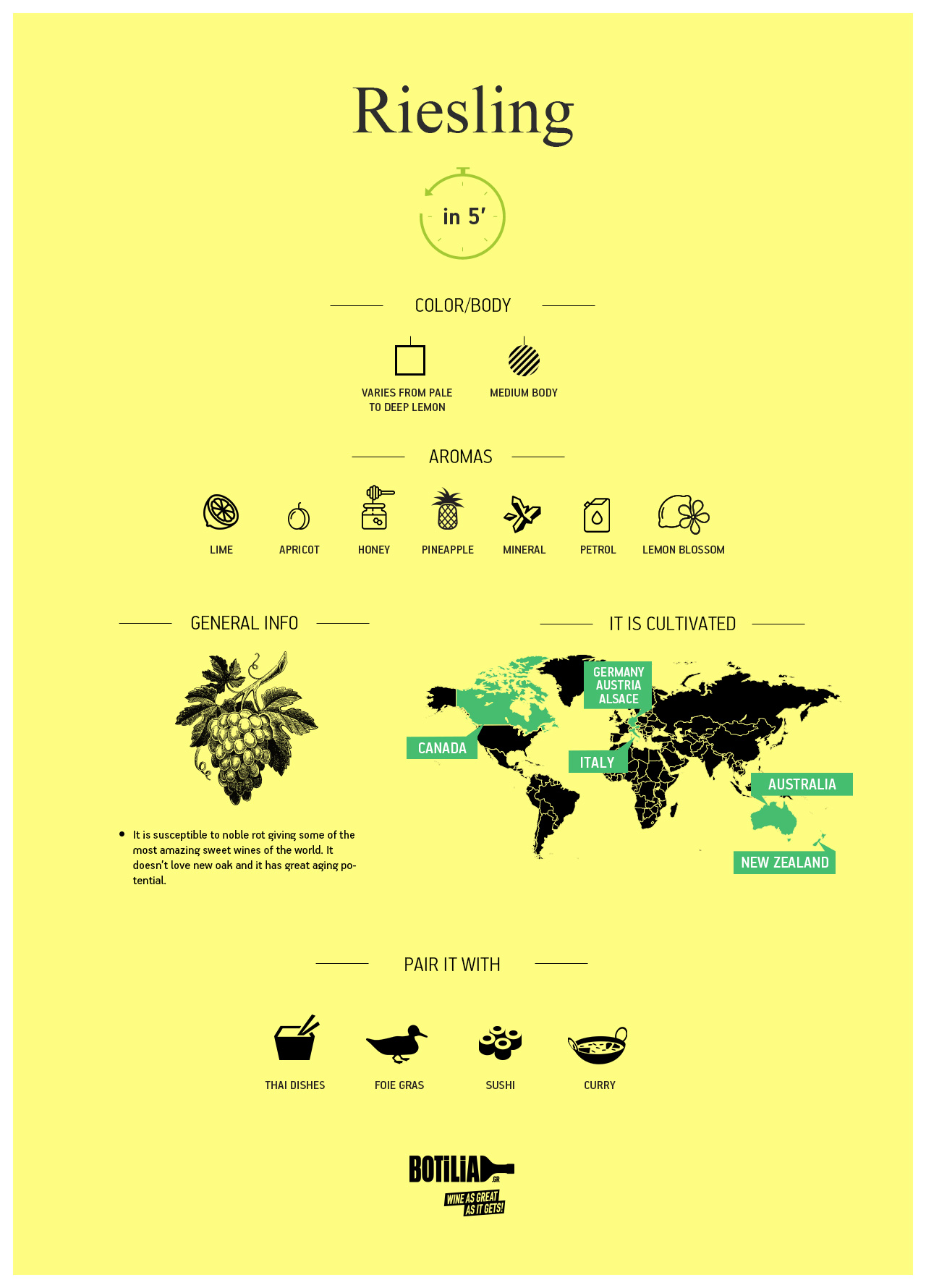RIESLING IN 5'!

GENERAL INFO
Riesling was born in Rhine region of Germany and the first mention of wine was made in 1435 at the cellar of the noble, John IV Katzenelnbogen. Even then, it seems that they had recognized its worth, and so wine was the privilege of the noble Germans, who carried it with them to every diplomatic or formal meeting in the world.
It has a unique ability to reflect the terroir and climate of the area where it grows. It is cultivated in many regions giving wines that retain their typical character but have very different aromatic profiles and styles. Riesling has two more virtues that make it super amazing: 1) it is susceptible to botrytis and 2) its aging potential exceeds 50 years!
In its home country, Germany, we find it mainly in Mosel, Pfalz, Rheingau, and Rheinhessen. Their categorization is very interesting:
Qualitätswein / QbA: Wine that originates 100% from one of Germany's 13 designated wine regions. Basic wine of a single property.
Kabinett: The lightest and most subtle style of Riesling, from grapes harvested early in the harvest season.
Spätlese: Late harvest wine that has more complexity and body than Kabinett because the grapes ripen longer.
Auslese: Wine made from overripe grapes, often affected by botrytis (also known as "noble rot"). It has intense fruity character with rich, sweet taste, and is the most concentrated wine before we get to the realm of epic, dense and decadent dessert wines.
Beerenauslese / BA: Dessert wine from ultra-ripe grapes that are completely affected by botrytis. BAs are very intense and resemble to nectar.
Eiswein: Another rare dessert wine, similar to the condensed BA, but made from overripe grapes that have been frozen on the vine.
Trockenbeerenauslese / TBA: Germany's most amazing and rare sweet wine, made exclusively from selected grapes completely dried on the vine by botrytis.
CHARACTERISTICS
Riesling gives wines with sharp acidity, medium body and color ranging from pale lemon to deep lemon. It is quite aromatic with notes of lime, apricot, honeysuckle and mineral hints when it is young and characteristic petrol and honey notes when aged.
It ripens relatively quickly, so in warm climates it ripens so fast that its aromas aren’t fully developed and this results to flat and bland wines. In the cold climates of Germany, Austria and Alsace it gives wines of unique finesse, complexity and balance. It can give from dry to very sweet dessert wines. In the warmer vintages, in Rheingau, sweet wines with great concentration, complexity and botrytis character are made (BA & TBA). Riesling from the New World has more concentrated fruit, tropical notes and they usually make many late harvest wines. Oak barrels are rarely used and when that happens they are usually large and very old barrels that do not affect the wine.
FOOD AND WINE PAIRING
The options are almost endless. A fresh, light Riesling with mineral character (from Washington, for example) is a great match for fresh fish with bold lemone sauces and shells. The rich and complex Alsatian or German Rieslings love earthy and spicy flavors like chicken with wild mushrooms, curry with chicken or veal, fatty but delicate cheeses with dried fruit, duck with orange and I can continue like this forever… Rieslings with a hint of sweetness are perfect with spice Thai dishes as well as sushi or slightly sweet dishes like pumpkin soup with cardamom. Ausleses are great for foie gras since they can complement its texture and fattiness. Eiswines and beerenausleses can definitely accomany fruit desserts but the secret is to put them next to complex salty cheeses like Blue d 'Auvergne!
Eva Markaki
Wine Geek


